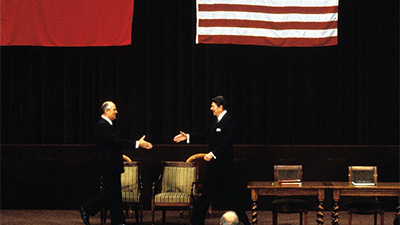Cold War and Decolonization c. 1900 to the Present
Teacher Resources
Driving Question: How did the intertwined trends of the Cold War and decolonization impact societies around the world from c. 1900 to the present?
The competition between the United States and the Soviet Union during the Cold War intensified throughout the late 1940s, and continued until the end of the 1980s. Over this period, the two sides engaged in an aggressive arms race that threatened the world with the specter of nuclear war. While the United States and the Soviet Union ultimately did not fight each other directly, they each supported and emboldened smaller countries into engage in regional conflicts.
Learning Objectives
- Explain the historical context for the entanglement of the Cold War and decolonization after 1900.
- Use the AP themes to evaluate how the Cold War and decolonization impacted societies around the world.
Vocab Terms:
- capitalism
- Cold War
- communism
- decolonization
- ideological
- sovereignty
- superpower
Opener: Cold War and Decolonization
To teach this lesson step, refer to page 3 of the Lesson 8.0 Teaching Guide.
Looking for more maps? Check out OER Project’s collection of Maps.
As you get ready to learn about the Cold War, consider what you think you know and what you know you don’t know.
Unit 8 Overview
To teach this lesson step, refer to page 3 of the Lesson 8.0 Teaching Guide.
Two conflicts dominated the latter half of the twentieth century: decolonization and the Cold War. Two superpowers emerged from the destruction of World War II: the United States and Soviet Union. Learn how competition between these two superpowers led to the ideological conflict known as the Cold War.
-
Guiding Questions
-
Before you watch
Preview the questions below, and then review the transcript.
While you watch
Look for answers to these questions:
- How did the Cold War impact the city of Cuito Cuanavale?
- Why did many formerly colonized regions demand independence after World War II?
- How can the Cold War be described concerning the themes of governance, economics, cultural developments and interactions, and social interactions and organization?
- Why didn’t the US and USSR engage each other in a “hot” war, or direct conflict, during this period?
- How did soldiers from Cuba and South Africa end up fighting in the Angolan Civil War?
After you watch
Respond to the following question: In the video, John Arthur states that the “Cold War and decolonization were both continuations of some of the trends you saw at the end of Unit 7.” What continuities from Unit 7 (Global Conflict) can be seen in Unit 8 (Cold War and Decolonization)?
Key Ideas
Unit 8 Introduction: Cold War and Decolonization
To teach this lesson step, refer to page 4 of the Lesson 8.0 Teaching Guide.
This article provides an overview of the complicated global tensions that emerged after World War II, setting the stage to help you learn more about the entangled conflicts of the Cold War and decolonization later in this unit
-
Guiding Questions
-
Before you read
Preview the questions below, and then skim the article. Be sure to look at the section headings and any images.
While you read
Look for answers to these questions:
- How did the Second World War reshape global power structures?
- Why were some conflicts during this period described in different ways (Cold War struggles vs. decolonization) depending on different perspectives?
- How was the Cold War an ideological struggle?
- What changes in the world today came about as a result of political independence and decolonization?
After you read
Respond to the following questions:
- How do the ideological differences between the Soviet Union and the United States relate to the theme of cultural developments and interactions? How do they relate to economic systems?
- How do you think the events of the Cold War and/or decolonization might have affected people in your family?
Closer: Cold War and Decolonization
To teach this lesson step, refer to page 5 of the Lesson 8.0 Teaching Guide.
Check out the OER Project Informal Writing Routines Guide to generate other ideas about how to help students show their thinking through writing.
Make some predictions about what you’ll learn in this unit, as you agree or disagree with statements, and connect them to the AP themes.



